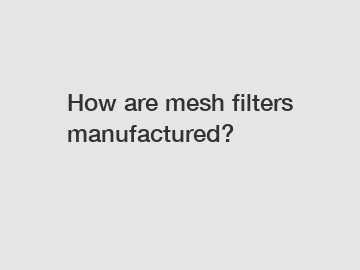How are mesh filters manufactured?
How are Mesh Filters Manufactured?
When it comes to filtration systems, mesh filters are a common choice due to their versatile nature and efficient performance. These filters provide exceptional mesh openings that allow for the separation of different materials based on their size. The manufacturing process of mesh filters involves several steps to ensure the production of high-quality filters that are suitable for various applications. In this article, we will explore the key steps involved in the manufacturing of mesh filters.
Raw Material Selection.

The first step in manufacturing mesh filters is selecting the appropriate raw material. Mesh filters are typically made from metal wires, such as stainless steel, copper, or brass. The selection of raw material depends on the specific application of the filter, considering factors like temperature, chemical compatibility, and corrosion resistance. Once the raw material is chosen, it undergoes a quality control process to ensure its suitability for production.
Wire Drawing.
After the raw material is selected, it goes through the wire drawing process. Wire drawing involves reducing the diameter of the wire by pulling it through a series of dies. This process ensures that the wire is consistent in size and has the required smoothness. The wire is then wound onto spools, ready to be used in the mesh filter manufacturing process.
Weaving Process.
The next step is the weaving process, where the mesh is formed. The wire is loaded onto weaving machines that have different patterns and configurations to create different mesh designs. The machines interlace the wires vertically and horizontally to form the desired mesh pattern. This process requires precision and expertise to ensure the uniformity and accuracy of the mesh openings.
Bonding or Edge Treatment.
Once the mesh is woven, it undergoes a bonding or edge treatment process. This step involves securing the mesh edges to prevent fraying and enhancing the overall durability of the filter. Depending on the type of filter and its application, different bonding or edge treatment methods can be employed. Some common methods include spot welding, soldering, or using adhesive materials.
Cutting and Shaping.
After the bonding or edge treatment, the mesh filters go through cutting and shaping processes to achieve the desired dimensions. The mesh can be cut into various shapes and sizes, such as discs, tubes, or custom-made shapes based on specific requirements. This step is crucial to ensure that the filters fit seamlessly into the intended systems or applications.
Quality Control and Inspection.
Throughout the manufacturing process, quality control and inspection play a vital role. Each fabricated mesh filter undergoes rigorous testing and examination to ensure that it meets the desired specifications. Quality control measures include checking for defects, such as broken wires, irregular mesh openings, or improper bonding. The filters are also inspected for their overall durability and ability to withstand the designated operating conditions.
Closing Paragraph:
In conclusion, the manufacturing of mesh filters involves selecting the appropriate raw material, wire drawing, weaving, bonding or edge treatment, cutting and shaping, and rigorous quality control measures. These steps ensure the production of high-quality mesh filters that cater to various filtration needs. If you require mesh filters or have any inquiries, please feel free to contact us. Our team will be happy to assist you in finding the right mesh filter solution for your specific application.
If you are looking for more details, kindly visit SIC ceramic foam filter, Aluminium Filtration Fiberglass Fabric, High-Silica Mesh.


